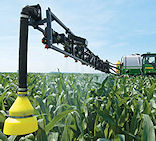July 28, 2009

This has been an unusual summer, cool and wet, and soybean foliar diseases can flourish in such conditions, says X.B. Yang, Iowa State University Extension plant pathologist. As the weather trend of cool and wet continues, there are questions about the use of soybean fungicides to manage the risk of soybean foliar diseases.
Now in the latter part of July plants in many soybean fields in Iowa are approaching the R3 growth stage which is critical to the effective use of foliar fungicide sprays. In the following report, X.B. Yang answers some questions on fungicide applications for soybeans this summer.
* What's happening in Iowa soybean fields? Last week many ISU Extension field agronomists across the state reported seeing foliar diseases on corn and soybean plants. Soybean brown spot and frogeye leaf spot were reported with some reports of high levels of prevalence. "My own field scouting also indicates the level of these diseases is higher than in a normal season, which is not surprising due to the cooler and wetter-than-normal weather," says Yang.
* When should you spray? The R3 growth stage of soybeans is the time to pull the trigger if foliar disease risk is high in your soybean fields. Application at R1 or earlier did not pay off in the past several years of ISU studies. Application at R3 consistently produces the highest yields across Iowa and surrounding states. R3 is the growth stage when soybean starts to set pods.
* How to assess the risk of disease? Even when the season is cool across Iowa, the disease risk is not evenly spread. This year the summer temperatures are cooler than those during the past four seasons. Different fungal pathogens like different temperatures. There is little quantitative information available on how to assess soybean foliar disease risk under unusually cool temperatures, especially for frogeye leaf spot, brown spot, and Cercospora leaf spot. Here are few points that may be helpful:
1) If you consistently had positive results spraying a foliar fungicide in your fields in the past four years, the chance is higher that you will have positive results this year from such an application.
2) Data from different sectors suggests that in the last four years in Iowa when precipitation was plentiful, more than 50% of the fungicide sprays yielded economical return and more than 70% of the sprays provide positive yield.
3) If your fields are on high ground and never had foliar disease problems in the past, the risk would be low.
4) If you had white mold disease infest your soybean field in the past and your soybeans had a dense canopy in mid-July or earlier, white mold risk is high.
What type of disease control strategy will not work?
Many farmers, agronomists and crop consultants report the occurrence of bacterial blight, a disease caused by a bacterium. The disease likes cool and wet weather and is mostly seen on the top canopy of the plants. Any fungicides will not be effective to reduce bacterial blight.
Another disease that most fungicides have little effect on is soybean white mold. Additionally, it is too late to control white mold when the fungicide is applied at R3 growth stage of soybeans. And effective spraying for control of white mold should be carried out at the R1 growth stage of soybeans. That's because the white mold fungus infects soybean plants through dead flowers on the bean plants.
You May Also Like




